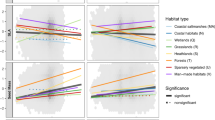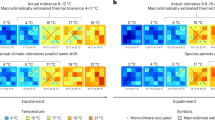Abstract
This paper investigates, with predictive models, the utility of ecophysiological responses to climate as predictors of plant distribution. At the global scale responses to extreme minimum temperatures and to the hydrological budget effectively predict the distribution limits of the major vegetation types of the World. A minimum temperature of -15°C, for example, appears critical in controlling the poleward spread of vegetation that is dominated by evergreen broadleaved species; however, the presence or absence of more frost resistant species, such as those that are deciduous broadleaved, is not obviously explained in terms of extremes of climate. In such cases, predicting the competitive relationships between species is necessary and dependent on the climatic sensitivity of population dynamics.
Similar content being viewed by others
References
Addicott F. T. & Lyons J. L., 1973. Physiological ecology of abscission. In: T. T.Kozlowski (ed.), Shedding of plant parts, pp. 85–124. Academic Press, New York.
Axelrod D. I., 1966. Origin of deciduous and evergreen habits in temperate forests. Evolution 20: 1–15.
Bliss L. C., 1956. A comparison of plant development in microenvironments of Arctic and Alpine tundra. Ecol. Monogr. 26: 303–337.
Box E. O., 1981. Macroclimate and plant forms: An introduction to predictive modeling in phytogeography. Junk, The Hague.
Callaghan T. V. & Collins N. J., 1981. Life cycles, population dynamics and the growth of tundra plants. In: L. C.Bliss, O. W.Heal & J. J.Moore (eds), Tundra ecosystems: a comparative analysis, pp. 257–284. Cambridge University Press, Cambridge.
Doley D., 1981. Tropical and subtropical forests and woodlands. In: T. T.Kozlowski (ed.), Water deficits and plant growth, Vol. VI pp. 209–323. Academic Press, New York.
Grier C. C. & Running S. W., 1977. Leaf area of mature north-western coniferous forests: relation to site water balance. Ecology 58: 893–899.
Harper J. L., 1967. Population biology of plants. Academic Press, London.
Holdridge L. R., 1967. Life zone ecology (rev. ed.). Tropical Science Center, San Jose, Costa Rica.
Larcher, W., 1981. Low temperature effects on Mediterranean sclerophylls: an unconventional viewpoint. In: N. S. Margaris & H. A. Mooney (eds), Components of productivity of mediterranean climate regions — basic and applied aspects, pp. 259–266.
Levitt J., 1980. Responses of plants to environmental stresses. Vol. 1. Chilling, freezing and high temperature stresses. 2nd ed. Springer, Berlin.
MacArthur R. H., 1972. Geographical ecology: Patterns in the distribution of species. Harper & Row, New York.
McMichael B. L., Jordan W. R. & Powell R. D., 1973. Abscission processes in cotton: induction by plant water deficit. Agron. J. 65: 202–204.
Merrill E. D.. 1945. Plant life of the Pacific world. Macmillan, New York.
Monteith J. L., 1965. Evaporation and environment.In: G. E.Fogg (ed.), The state and movement of water in living organisms. Symposium of the Society for Experimental Biology, 19, pp. 205–234. Cambridge University Press, Cambridge.
Müller M. J., 1982. Selected climatic data for a global set of standard stations for vegetation science. Junk, The Hague.
Polunin N., 1960. Introduction to plant geography and some related sciences. Longmans, London.
Rutter A. J., 1968. Water consumption by forests. In: T. T.Kozlowski (ed.), Water deficits and plant growth Vol. II. pp. 23–84. Academic Press, New York.
Sakai A., 1978. Freezing tolerance of evergreen and deciduous broadleaved trees in Japan with reference to tree regions, Low Temp. Sci., Ser. B. 36: 1–19.
Sakai A., 1979. Freezing avoidance mechanism of primordial shoots of conifer buds. Pl. Cell Physiol. 20: 1381–1390.
Sakai A. & Wardle P., 1978. Freezing resistance of New Zealand trees and shrubs. N. Z. J. Ecol. 1: 51–61.
Sakai A. & Weiser C. J., 1973. Freezing resistance of trees in North America with reference to tree regions. Ecology 54: 118–126.
Satoo T., 1983. Temperate broad-leaved evergreen forests of Japan. In: J. D.Ovington (ed.), Ecosystems of the world. 10. Temperate broad-leaved evergreen forests pp. 169–189. Elsevier, Amsterdam.
Schnelle, F., Baumgartner, A. & Freitag, E., 1984. Arboreta Phaenologica 28.
Schulze, E.-D., 1982. Plant life forms and their carbon, water and nutrient relations. In: O. L. Lange, P. S. Nobel, C. B. Osmond & H. Ziegler (eds), Encyclopedia of Plant Physiology, Vol. 12B, pp. 616–676.
Senser M. & Beck E., 1977. On the mechanisms of frost injury and frost hardening of spruce chloroplasts. Planta 137: 195–201.
Spurr S. H. & Barnes B. V., 1980. Forest ecology. 3rd ed. Wiley, New York.
Tieszen L. I., Lewis M. C., Miller P. C., Mayo J., ChapinIII F. S. & Oechel W., 1981. An analysis of processes of primary production in tundra growth forms. In: L. C.Bliss, O. W.Heal & J. J.Moore (eds), Tundra ecosystems: a comparative analysis, pp. 285–356. Cambridge University Press, Cambridge.
Von Humboldt, A. & Bonpland. A., 1805. Essai sur la géographie des plantes; accompagné d'un tableau physique des régions equinoxales. Paris.
Waring R. H., Emmingham W. H., Gholz H. L. & Grier C. C., 1978. Variation in maximum leaf area of coniferous forests in Oregon and its ecological significance. For. Sci. 24: 131–140.
Woodward F. I., 1986. Climate and plant distribution. Cambridge University Press, Cambridge.
Woodward F. I. & Jones N., 1984. Growth studies of selected plant species with well-defined European distributions. I. Field observations and computer simulations on plant life cycles at two altitudes. J. Ecol. 72: 1019–1030.
Author information
Authors and Affiliations
Additional information
We are grateful to Hans de Kroon for discussions on the application of matrices to ecology.
Rights and permissions
About this article
Cite this article
Woodward, F.I., Williams, B.G. Climate and plant distribution at global and local scales. Vegetatio 69, 189–197 (1987). https://doi.org/10.1007/BF00038700
Accepted:
Issue Date:
DOI: https://doi.org/10.1007/BF00038700




